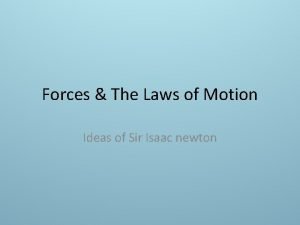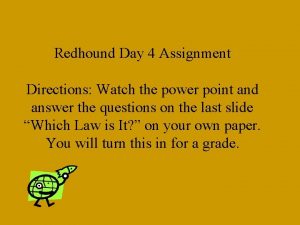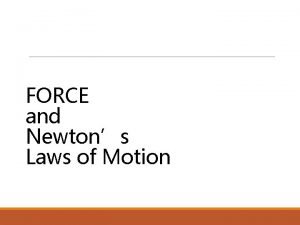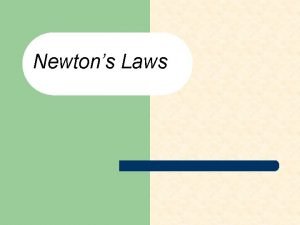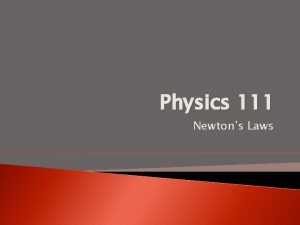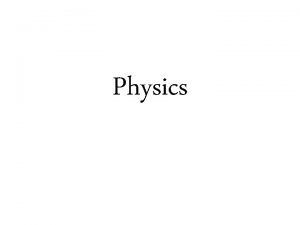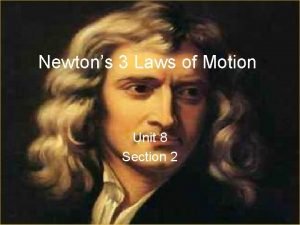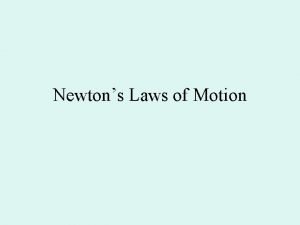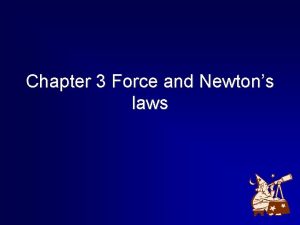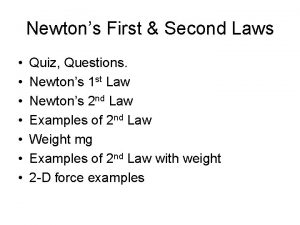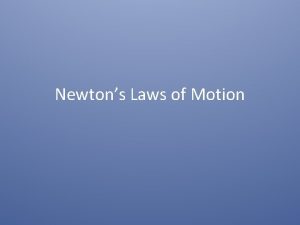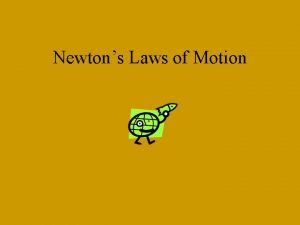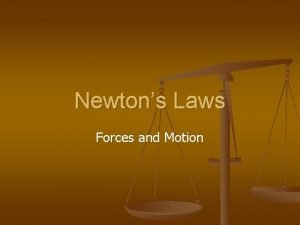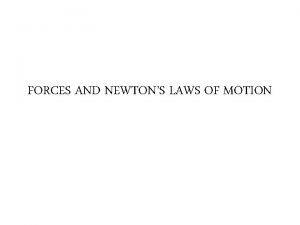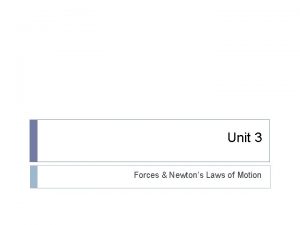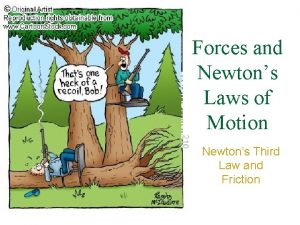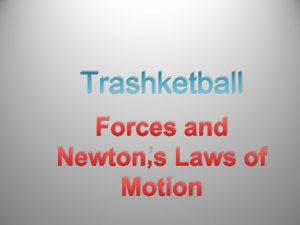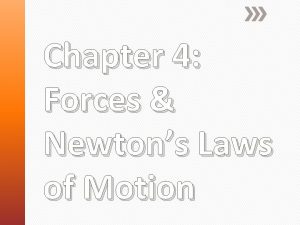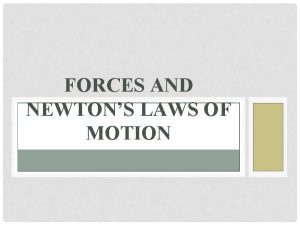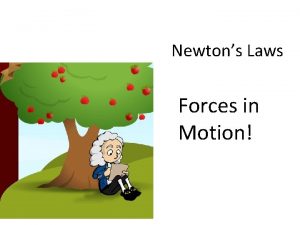FORCES NEWTONS LAWS OF MOTION WHAT IS NEWTONS



















- Slides: 19

FORCES NEWTON’S LAWS OF MOTION

WHAT IS NEWTON’S FIRST LAW OF MOTION? • If an object is not moving, it will not start moving until a force acts on it. • If an object is moving, it will continue at a constant velocity until a force acts to change its speed or its direction.

• Newton’s first law of motion states that an object at rest will remain at rest unless acted upon by a nonzero net force. • An object moving at a constant velocity will continue moving at a constant velocity unless acted upon by a nonzero net force.

INERTIA • All objects, moving or not, resist changes in motion. • Resistance to change in motion is called inertia. • Newton‘s first law of motion is also called the law of inertia. • Inertia explains many common events.

INERTIA DEPENDS ON MASS • Some objects have more inertia than others. • The greater the mass of an object, the greater its inertia, and the greater the force required to change its motion. • A full backpack is harder to move than an empty one because it has more mass and therefore more inertia.

• Around and Around Lab • Homework is pages 46 & 47

WHAT IS NEWTON’S SECOND LAW OF MOTION? • Which is harder to push, a full shopping cart or an empty one? • Who can cause a greater acceleration on a shopping cart, a small child or a grown adult?

CHANGES IN FORCE AND MASS • Suppose you increase the force on a cart without changing its mass. • The acceleration of the cart will also increase. • Your cart will also accelerate faster if something falls out. • This reduces the mass of the cart, and you keep pushing just as hard.

DETERMINING ACCELERATION • Newton’s second law of motion states that an object’s acceleration depends on its mass and on the net force acting on it. • This relationship can be written as follows. • Acceleration = net force / mass

• This formula can be rearranged to show much force must be applied to an object to get it to accelerate at a certain rate. • Net force = mass x acceleration

• Acceleration is measured in meters per second (m/s 2). • Mass is measured in kilograms (kg). • Newton’s second law shows that force is measured in kilograms times meters per second (kg x m/s 2). This unit is also called the newton (N), which is the SI unit of force. • One newton is the force required to give a 1 kg mass an acceleration of 1 m/s 2.

• Newton’s Second Law Lab • Homework is pages 48 -51

WHAT IS NEWTON’S THIRD LAW OF MOTION? • If you leaned against a wall and it didn’t push back on you, you’d fall through. • The force exerted by the wall is equal in strength and opposite in direction to the force you exert on the wall. • Newton’s third law of motion states that if one object exerts a force on another object, then the second object exerts a force of equal strength in the opposite direction on the first object. • Another way to state Newton’s third law is that for every action there is an equal but opposite reaction.

ACTION-REACTION PAIRS • Pairs of action and reaction forces are all around you. • When you walk, you push backward on the ground with your feet. • Think of this as an action force. (It doesn’t matter which force is called the “action” force and which is called the “reaction” force. )

• The ground pushes forward on your feet with an equal and opposite force. • This is the reaction force. • You can only walk because the ground pushes you forward!

DETECTING MOTION • If you drop your pen, gravity pulls the pen downward. • According to Newton’s third law, the pen pulls Earth upward with an equal and opposite reaction force. • You see the pen fall. • You don’t see Earth accelerate toward the pen.

• Remember Newton’s second law. • If mass increases and force stays the same, acceleration decreases. • The same force acts on both Earth and your pen. • Since Earth has such a large mass, its acceleration is so small that you don’t notice it.

DO ACTION-REACTION FORCES CANCEL? • You have learned that two equal forces acting in opposite directions on an object cancel each other out and produce no change in motion. • So why don’t the action and reaction forces in Newton’s third law of motion cancel out as well? • Action and reaction forces do not cancel out because they act on different objects.

• Interpreting Illustrations Lab • Homework is pages 52 -55
 Newtons laws od motion
Newtons laws od motion Newtons first lw
Newtons first lw Newtons 3 laws
Newtons 3 laws Three laws of motion
Three laws of motion Forces and the laws of motion problem b
Forces and the laws of motion problem b Motion examples in everyday life
Motion examples in everyday life Newton's 3rd law example
Newton's 3rd law example Newton's 3 laws
Newton's 3 laws Newtons laws
Newtons laws Abcd8n
Abcd8n It's friday night and skyler has been assigned
It's friday night and skyler has been assigned Newton's laws
Newton's laws Third law of newton
Third law of newton Newton 3 law of motion
Newton 3 law of motion What are newton's 3 laws
What are newton's 3 laws Newton's law
Newton's law Newton's 5th law
Newton's 5th law Section 3 using newtons laws
Section 3 using newtons laws Law of force and acceleration
Law of force and acceleration Newtons 3 laws quiz
Newtons 3 laws quiz




